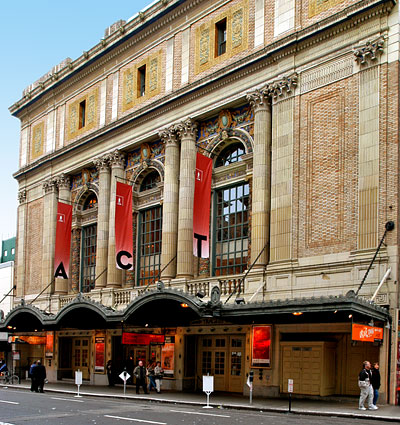National Register of Historic Places in San Francisco
Geary Theatre
415 Geary Street Between Mason and Taylor
Built 1910
The Geary Theater opened as the Columbia Theatre. Among those who played the Columbia were Sarah Bernhardt and Isadora Duncan. The theater was renamed the Wilkes Theater, then the Lurie Theater and finally, then the Geary Theater and finally in 2006, the American Conservatory Theater. (Sarah Bernhardt said theatre; ACT says theater.)
For the next forty years, all the major players of the American stage performed here: George Arliss, Edward G. Robinson, Basil Rathbone, Frederic March, Ethel Barrymore, Ina Claire, Paul Muni, Ethel Waters, Boris Karloff, Paul Robeson, Alfred Lunt, Lynne Fontanne, Katherine Cornell, Cornelia Otis Skinner, and Judith Anderson.
In January 1967, the Geary Theater became the home of the American Conservatory Theater, under the direction of William Ball. In the 1967-1968 season, Mr Ball presented an astounding two dozen productions including Hamlet, Long Day's Journey into Night, A Streetcar Named Desire, The Misanthrope, Tartuffe, Tiny Alice, Endgame, and The Crucible.
Fifteen years later on October 17, 1989, the Loma Prieta Earthquake caused major damage to the theater less than two hours before an evening performance. The proscenium arch collapsed, ripping a huge hole in the ceiling and crushing the lighting bridge and the first six rows of orchestra seats beneath tons of fallen plaster, but no one was injured.
ACT raised over $28.5 million for renovation, seismic stabilization and technology upgrades. The restored theater has retained its original character both inside and out, and is among the finest in the country.
ACT, under the direction of Cary Perloff, has been consistently delivering the goods on stage.
The theatre is also San Francisco Landmark 82.

The 1906 San Francisco earthquake precipitated a crisis without precedent in the history of the American theatre. San Francisco - renowned for the variety and the frequency of its cultural events, "the only city in the United States, outside of New York, where a high-salaried player could be assured a long and lucrative run" - suddenly and devastatingly lost all eight of its downtown theatres in the fiery holocaust which followed the April 18 quake.
Fortunately, culture-conscious citizens considered the replacement of these performing spaces as an important part of reconstruction activities. During the years 1906-1911, eight new theatres were built in downtown San Francisco. Each represented the very latest achievements in theatre design and technology, as well as luxurious elegance and comfort for audiences.
Half a century later, however, San Francisco theatres were again in crisis. This time, the danger came not from an Act of God but from acts of men. As Herb Caen wrote in 1957:
San Francisco's "theatre belt," which once boasted eight first-rate houses running simultaneously, has shrunk considerably of late, owing to the impact of television and movies and the diminished number of travelling companies. The "belt" now contains three theatres, and is perhaps more accurately described as a "garter."
The three theatres referred to by Caen were the Alcazar, the Curran and the Geary. The Alcazar was torn down in 1962 to make room for a parking lot. Of the eight theatres built during the years of earthquake reconstruction, only the Geary has remained in continual year-round operation as a professional theatre, faithfully and reverently maintained for its historical accuracy as well as its excellence as a performing space.
Excerpted from the NRHP Nomination.
